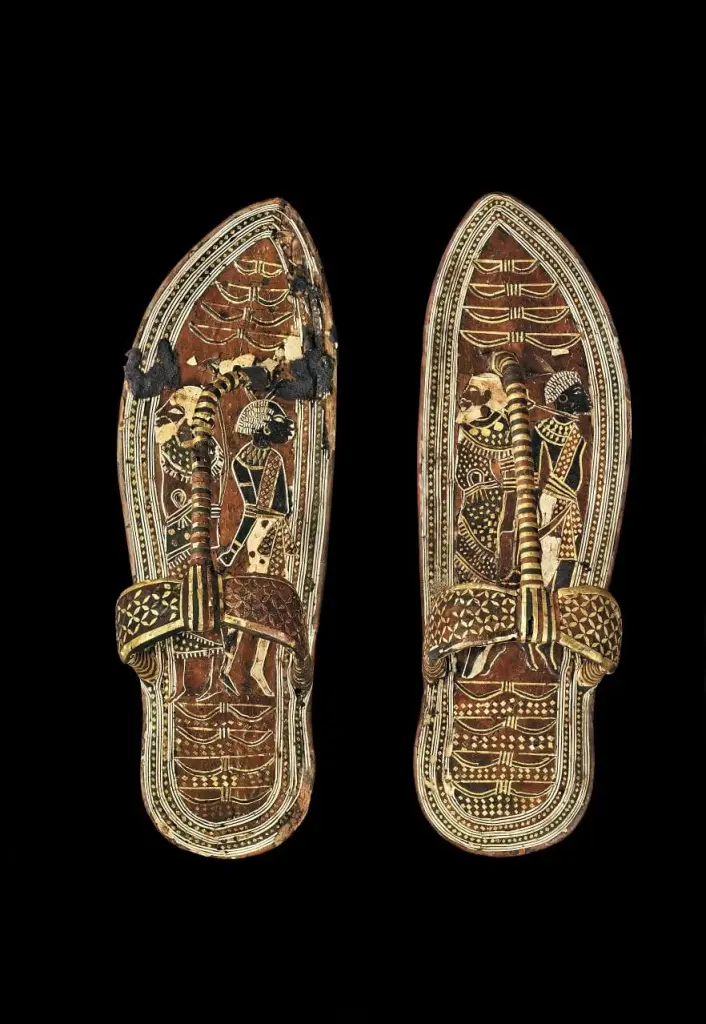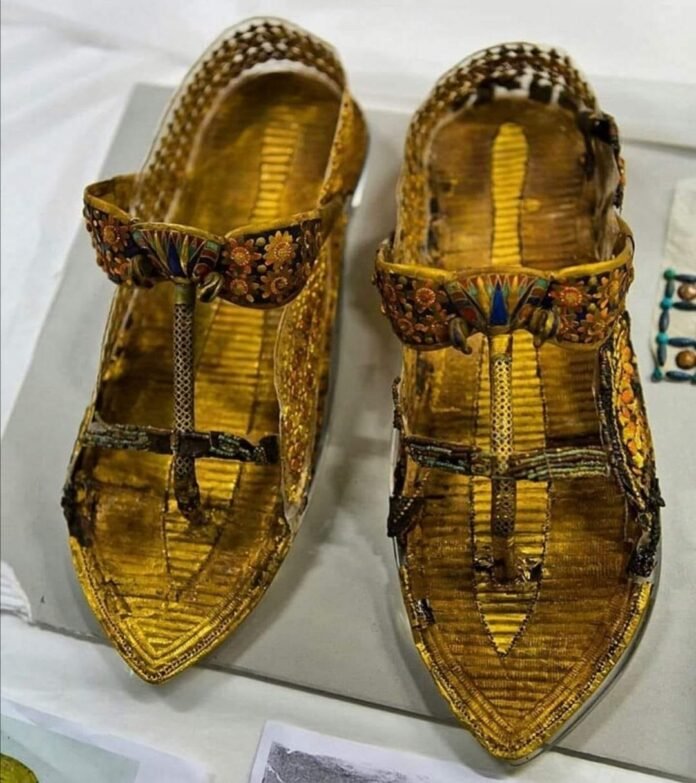In the ancient land of Egypt, during the reign of the young Pharaoh Tutankhamun, a peculiar pair of sandals held a significant role. These sandals were no ordinary footwear; they were adorned with symbols of power and dominance. When the young king wore them, he symbolically trampled upon his enemies, as depicted by the nine bows, representing Egypt’s traditional adversaries, intricately designed on the top and bottom of the sandals.
The sandals, made from leather, featured detailed depictions of Egypt’s foes on their soles. There were four human figures portraying Asiatic and African neighbors, who were bound and prostrate, depicted as prisoners. This vivid imagery was a constant reminder of the enemies that King Tutankhamun would vanquish in his journey through life and into the afterlife.

In the tomb of Tutankhamun, a treasure trove of footwear was discovered. While the exact number of sandals remains uncertain, it is known that at least eighty samples were found. These sandals were meticulously crafted to accompany the young Pharaoh into eternity. Among the collection, some sandals were remarkably well-preserved, while others had deteriorated into mere fragments of foot straps. The most splendid of all were the golden sandals that adorned the feet of King Tutankhamun’s mummy, a testament to his royal stature.
Tutankhamun’s collection included various types of sandals. The most common were sewn sandals made from papyrus strips, likely used for daily activities. On the other end of the spectrum were the boy-king’s solid gold sandals, which were never meant to be worn in life but were intended for his eternal journey. These golden sandals adorned his feet as he lay in his solid gold coffin, symbolizing his status and preparing him for the afterlife.

Among the most intriguing were his leather sandals, which were meticulously crafted like a mosaic. They featured Syrian and Nubian prisoners on the soles, allowing Tutankhamun to symbolically step on Egypt’s traditional enemies with every step he took. This imagery served not only as a symbolic gesture but also as a powerful reminder of his authority and the protection it afforded him.
It is noteworthy that none of Tutankhamun’s footwear showed asymmetrical wear, challenging the claims that he was lame. This detail underscores the importance of these sandals not just as practical items but as symbolic artifacts of his reign.
The depiction of enemies on Tutankhamun’s leather sandals, while not explicitly documented, carried profound symbolic meaning. In ancient Egyptian art and symbolism, enemies represented the king’s ability to conquer and subdue opposing forces. The presence of these figures on his sandals likely symbolized Tutankhamun’s role as a powerful ruler who successfully defended Egypt against its adversaries. Moreover, it reflected his desire for protection and the belief in the magical properties of such depictions.

By showcasing defeated enemies on his attire, Tutankhamun projected an image of strength and power to his subjects and potential challengers. This symbolism served as a visual reminder of his authority and ability to maintain order within Egypt. However, it is essential to recognize that ancient Egyptian symbolism often carried multiple layers of meaning, varying depending on the context.
Without specific textual or iconographic evidence directly explaining the symbolism of these enemies, any interpretation remains speculative. Nevertheless, the legacy of Tutankhamun’s sandals endures, embodying the rich tapestry of ancient Egyptian culture and the powerful imagery that defined his reign.
Thus, the story of Tutankhamun’s sandals transcends mere footwear; it encapsulates the essence of a young king’s power, the enemies he symbolically conquered, and the eternal journey he embarked upon, leaving behind a legacy that continues to captivate the world.
In the New Kingdom, during the late 18th Dynasty, around 1332-1323 BC, these sandals were crafted. They were discovered in the tomb of Tutankhamun (KV62) in the Valley of the Kings, West Thebes, and now reside in the Egyptian Museum in Cairo, bearing the catalogue number JE 62685.




